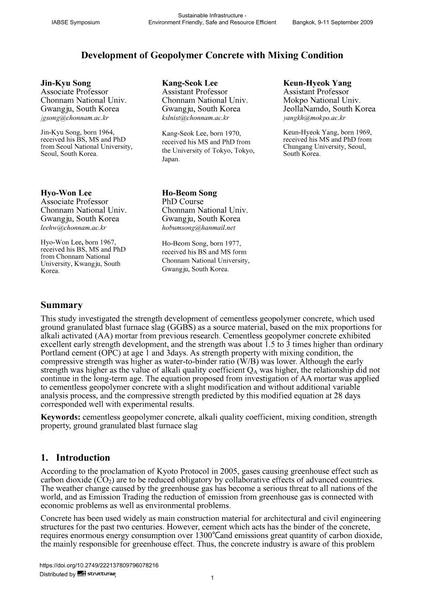Development of Geopolymer Concrete with Mixing Condition

|
|
|||||||||||
Bibliografische Angaben
| Autor(en): |
Jin-Kyu Song
Kang-seok Lee Keun-Hyeok Yang Hyo-Won Lee Ho-Beom Song |
||||
|---|---|---|---|---|---|
| Medium: | Tagungsbeitrag | ||||
| Sprache(n): | Englisch | ||||
| Tagung: | IABSE Symposium: Sustainable Infrastructure - Environment Friendly, Safe and Resource Efficient, Bangkok, Thailand, 9-11 September 2009 | ||||
| Veröffentlicht in: | IABSE Symposium Bangkok 2009 | ||||
|
|||||
| Seite(n): | 32-41 | ||||
| Anzahl der Seiten (im PDF): | 8 | ||||
| Jahr: | 2009 | ||||
| DOI: | 10.2749/222137809796078216 | ||||
| Abstrakt: |
This study investigated the strength development of cementless geopolymer concrete, which used ground granulated blast furnace slag (GGBS) as a source material, based on the mix proportions for alkali activated (AA) mortar from previous research. Cementless geopolymer concrete exhibited excellent early strength development, and the strength was about 1.5 to 3 times higher than ordinary Portland cement (OPC) at age 1 and 3days. As strength property with mixing condition, the compressive strength was higher as water-to-binder ratio (W/B) was lower. Although the early strength was higher as the value of alkali quality coefficient QA was higher, the relationship did not continue in the long-term age. The equation proposed from investigation of AA mortar was applied to cementless geopolymer concrete with a slight modification and without additional variable analysis process, and the compressive strength predicted by this modified equation at 28 days corresponded well with experimental results. |
||||
